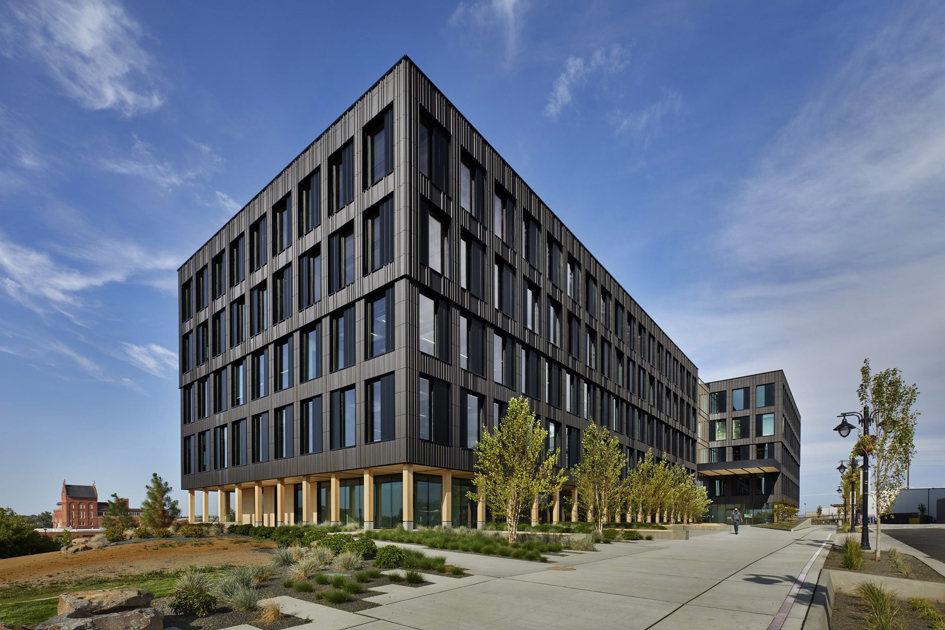Mass Timber Building Enclosures
Design and performance considerations for modern construction
Sponsored by Think Wood
Webinar On-Demand
Modern mass timber buildings are designed and constructed for style and performance. Built of engineered wood products, these projects allow industry professionals to diversify the use of wood materials while shortening construction schedules. Of late, larger and taller mass timber structures are growing in popularity throughout North America, resulting in the need for high-performance, efficient building enclosure assemblies that work hard and can be installed quickly.
Mass timber components, including cross-laminated timber (CLT) and nail-laminated timber (NLT) panels, and glulam beams and columns, among others, are frequently part of such building enclosures, including roofs, walls, and floor/soffits, elevating both the functional and aesthetic aspects of projects. The utilization of mass timber and/or prefabricated building enclosure elements not only helps to meet the strict structural and fire requirements associated with greater building heights and weights, but also aids in efficient heat, air, and water management systems, increasing the safety and ultimate well-being of building occupants. This webinar will present an overview of the benefits and considerations of mass timber building enclosure design as well as providing best practices via several case studies of successful projects that incorporated mass timber enclosures.
This webinar will present an overview of the benefits and considerations of mass timber building enclosure design as well as provide best practices via several case studies of successful projects that incorporated mass timber enclosures.
Featured in this webinar, among other projects, is the Catalyst Building project, which will be presented by Natalie Telewiak, M. Arch., LEED AP, and principal of Vancouver-based Michael Green Architecture (MGA). The Catalyst Building is the first office building in Washington State constructed out of cross-laminated timber and is designed to be a fully integrated living laboratory for new sustainability technologies, materials, construction techniques, operational practices, and design.
Located in Spokane, Washington, the 165,000 sq. ft., 5-story Catalyst Building is built on an irregular site, which was underutilized and in need of revitalization. The building is connected to the University District by way of the Gateway Bridge – a pedestrian bridge that brings together the two university core areas. Intended as a place where industry and academia can intersect to innovate and collaborate, the building required flexible spaces for both office and academic multi-functional uses. The floor plates were designed to be simple but long span to meet the program requirements.
A Life Cycle Assessment (LCA) of the building, authored by the Carbon Leadership Forum at the University of Washington, concluded that the carbon storage of the timber nearly offsets the embodied carbon impact of construction. By focusing on lower-carbon materials, the conversation around sustainability in the built environment can broaden from only energy usage to total carbon emissions over a building’s lifecycle. This project proves that sustainable development outcomes and new construction methods can coexist with more traditional metrics for affordability, operational efficiency, and tenant comfort. The Catalyst Building symbolizes both Spokane and Washington State’s commitments to sustainability, and it serves as a hub for growth in the region.
The webinar will conclude with a brief Q&A session.

Photo courtesy of MGA Architects
The Catalyst Building is the first office building in Washington State constructed out of cross-laminated timber and is designed to be a fully integrated living laboratory for new sustainability technologies, materials, construction techniques, operational practices, and design.

|
Natalie Telewiak, Principal at MGA | Michael Green Architecture. With an education in both architecture and engineering, Natalie’s approach to design is rooted in material logic, collaboration, and connection. As a Principal at MGA since 2018, she leads and inspires her team to deliver elegant solutions that marry structure, systems, manufacturing, and architecture. Natalie focuses on the potential for design to foster community, enhance health and well-being, and connect us back to nature by creating projects that are meaningful, innovative, and more sustainable. Natalie’s career highlights include the Governor General award-winning Ronald MacDonald House in Vancouver and a mass timber, multi-activity centre in Gallivare, Sweden, and she is currently working on several large-scale international projects, including Google’s first mass timber office development in California.. |

|
Colin Shane, M.Eng., P.Eng. P.E., Principal, Building Science Specialist, Regional Director, US West, RDH Building Science Inc. is a Professional Engineer in the United States and Canada and leads RDH’s team in the Western United States. Colin has a broad knowledge of building construction and applies building science principles to analyze and design durable, energy-efficient building enclosures. He shares his experience by regularly speaking about topics related to building science and building enclosure engineering at events across the United States and contributes to industry organizations with the aim of making buildings better. |
LEARNING OBJECTIVES
- Discuss key building enclosure design considerations for the construction of mass timber buildings that support safety requirements, high-performance, and architectural aesthetic goals.
- Explain the likely increased construction efficiency and potential cost savings through the utilization of prefabricated mass timber enclosure assemblies, especially in buildings of greater height.
- Describe common details and building materials used for mass timber wall and roof enclosure assemblies that help meet structural and fire requirements, as well as efficient heat, air, and water management systems to ensure safety, high-performance, and structural integrity.
- Cite details from the featured mass timber project case studies, including best practices associated with enclosure assemblies to ensure that occupant well-being is maximized and performance requirements are met.











